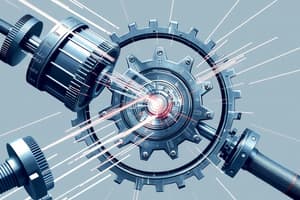Podcast
Questions and Answers
What is the primary goal of engineering mechanics?
What is the primary goal of engineering mechanics?
- Analyze the properties of materials under stress
- Analyze and predict the motion and deformation of objects under external forces (correct)
- Understand the chemical composition of materials
- Predict the behavior of bodies in motion
Which branch of engineering mechanics deals with bodies at rest?
Which branch of engineering mechanics deals with bodies at rest?
- Kinematics
- Statics (correct)
- Dynamics
- Material science mechanics
What is the definition of dynamics in engineering mechanics?
What is the definition of dynamics in engineering mechanics?
- Analysis of internal and external forces in a system
- Optimization of engineering systems
- Study of bodies in motion and the forces causing the motion (correct)
- Study of bodies at rest
Which field provides the theoretical basis for the design, analysis, and optimization of engineering systems?
Which field provides the theoretical basis for the design, analysis, and optimization of engineering systems?
In which branch of engineering mechanics are Newton's laws of motion applied to describe the motion of bodies?
In which branch of engineering mechanics are Newton's laws of motion applied to describe the motion of bodies?
What type of structures are analyzed in static equilibrium in engineering mechanics?
What type of structures are analyzed in static equilibrium in engineering mechanics?
What is a couple in the context of mechanics?
What is a couple in the context of mechanics?
What is the result of a couple in a mechanical system?
What is the result of a couple in a mechanical system?
Why are free body diagrams important in physics and engineering?
Why are free body diagrams important in physics and engineering?
What does the law of transmissibility of forces state?
What does the law of transmissibility of forces state?
In a free body diagram, what is represented by vectors with magnitude and direction?
In a free body diagram, what is represented by vectors with magnitude and direction?
What does the arm of a couple refer to?
What does the arm of a couple refer to?
What is the primary focus of Varignon's Theorem in engineering mechanics?
What is the primary focus of Varignon's Theorem in engineering mechanics?
Which engineering discipline would benefit from analyzing the motion of aircraft and spacecraft using dynamics principles?
Which engineering discipline would benefit from analyzing the motion of aircraft and spacecraft using dynamics principles?
What is the principle behind Lami's Theorem in statics?
What is the principle behind Lami's Theorem in statics?
In a system of forces, what does the term 'net force' represent?
In a system of forces, what does the term 'net force' represent?
Which type of forces have lines of action that all intersect at a common point?
Which type of forces have lines of action that all intersect at a common point?
Why is analyzing systems of forces important in mechanics and physics?
Why is analyzing systems of forces important in mechanics and physics?
'Coplanar Forces' refer to forces that:
'Coplanar Forces' refer to forces that:
'Collinear Forces' are distinguished by their lines of action that are:
'Collinear Forces' are distinguished by their lines of action that are:
What role does dynamics play in mechanical engineering?
What role does dynamics play in mechanical engineering?
How does Varignon's Theorem simplify the analysis of moments?
How does Varignon's Theorem simplify the analysis of moments?
Flashcards are hidden until you start studying
Study Notes
Engineering Mechanics
- Deals with the study of the behavior of bodies under the action of forces and their effect on the environment
- Forms the foundation for various engineering disciplines, including civil, mechanical, aerospace, and structural engineering
- Primary goals: analyze and predict the motion and deformation of objects under the influence of external forces
- Provides the theoretical basis for the design, analysis, and optimization of engineering systems
Classification of Engineering Mechanics
- Broadly classified into two main branches:
- Statics: deals with the equilibrium of bodies at rest, meaning objects that are not in motion
- Key concepts: analysis of forces acting on stationary structures, evaluation of internal and external forces, application of Newton's laws of motion for systems in equilibrium
- Example applications: structural engineering, static equilibrium of trusses, frames, and other structures
- Dynamics: involves the study of bodies in motion and the forces causing the motion
- Key concepts: application of Newton's laws of motion to describe the motion of bodies, analysis of acceleration, velocity, and position of objects over time, study of impacts, collisions, and forces causing motion
- Example applications: automotive engineering, aerospace engineering, mechanical engineering
- Statics: deals with the equilibrium of bodies at rest, meaning objects that are not in motion
Varignon's Theorem
- States that the moment of a force about any point is equal to the algebraic sum of the moments of its components about the same point
- Relates the moments of a system of coplanar forces about a point
- Simplifies the analysis of moments by providing a method to calculate the resultant moment without explicitly summing the individual moments
Lami's Theorem
- States that if three coplanar forces acting on a particle are in equilibrium, then each force is proportional to the sine of the angle between the other two forces
- Deals with the equilibrium of concurrent forces acting on an object
System of Forces
- Refers to a collection or arrangement of multiple forces acting on an object or a particle
- Forces are vector quantities with both magnitude and direction
- The system can be represented mathematically by considering the vector sum of individual forces
- The net force or resultant force is essential in determining the overall effect of all forces on the motion and equilibrium of an object
Types of Systems of Forces
- Concurrent Forces: forces whose lines of action all intersect at a common point
- Parallel Forces: forces whose lines of action are parallel to each other
- Coplanar Forces: forces that act in the same plane
- Non-coplanar Forces: forces that do not lie in the same plane
- Collinear Forces: forces whose lines of action are all along the same straight line
Couple
- A system of two forces of equal magnitude, opposite direction, and parallel lines of action, but not acting along the same line
- The distance between the lines of action is called the arm of the couple
- Produces a turning effect or moment without any translational motion
- The moment produced by a couple is independent of the point chosen as the axis of rotation
Free Body Diagram (FBD)
- A simplified representation of an object under consideration, showing all external forces acting on the object and their directions
- Isolates the object of interest from its surroundings, allowing for a clearer analysis of the forces and moments acting on it
- Components:
- Object: the main object or body under analysis
- Forces: all external forces acting on the object, drawn as vectors
- Contact Surfaces: any surfaces in contact with other objects or surfaces
Law of Transmissibility of Forces
- States that the point of application of a force can be moved anywhere along its line of action without changing the external reaction forces on a rigid body
Studying That Suits You
Use AI to generate personalized quizzes and flashcards to suit your learning preferences.





